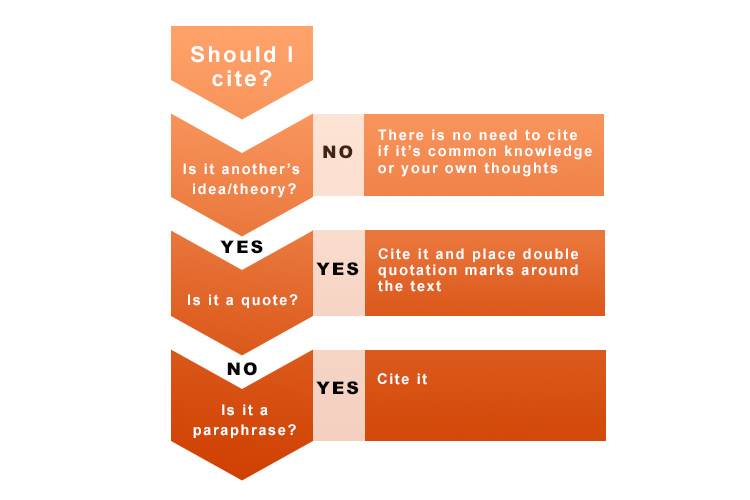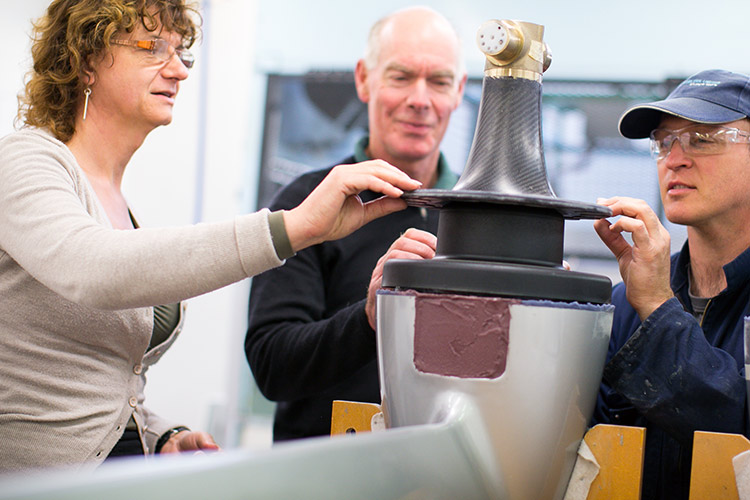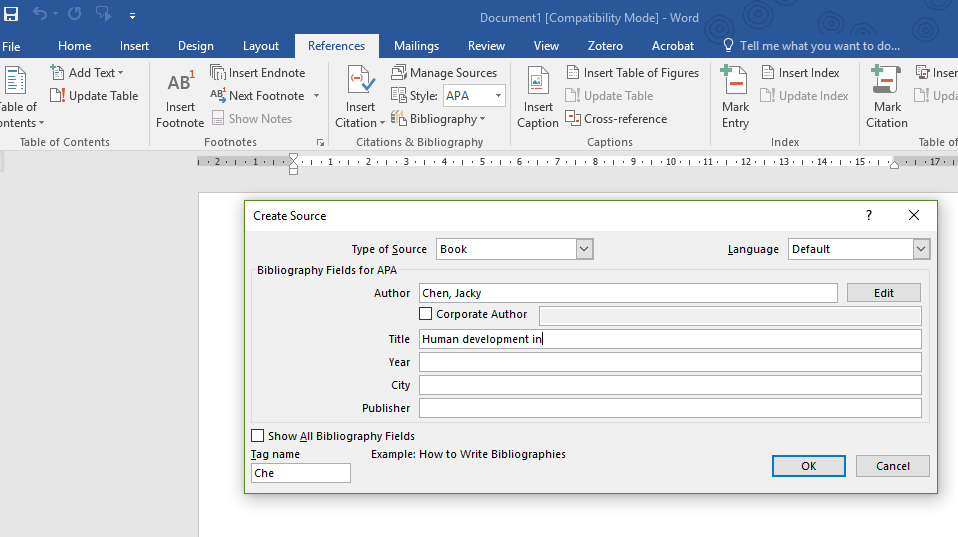Citing and referencing
Learn about taking information you have found in your research and using it in your writing while maintaining your academic integrity.
How to reference
Referencing is a standardised way of acknowledging the ideas, opinions or theories of authors that you have included in your own work. There are many different referencing styles. At Otago Polytechnic Te Pūkenga we most commonly use three different styles: APA, Chicago and Harvard. Please check with your teachers which style you are required to use.
References need to be included in assignments because they enable people to find the source of your ideas for further reference. They also add weight to your argument by showing you have used – and acknowledged the use of – legitimate sources. If you do not include references, you may be accused of plagiarism.
When referencing, your work will also include:
-
In-text citations, and/or
-
A reference list at the end of your work.
Tips to remember
- Keep track of everything you consult while you research your piece of work.
- Note down all the details before you start taking notes - you will need to reference each source in full.
- Write down the page numbers of any quotes you note.
- If you are unsure about the date or place of publication, check the library catalogue.
- Make sure you follow the required style of referencing carefully and accurately. Use the resources and make an appointment with a learning advisor if you have any questions or you would like some support in developing your referencing or research skills.
In-text citation
When you refer to another author's work in your work (either by direct quotation or paraphrasing), you must cite your source by providing the last name of the author and the year of publication in the body of your text.
You need to cite references to:
- Support your arguments and give your work a factual basis
- Protect yourself against charges of plagiarism
- Demonstrate to assessors or critics that you have carried out the necessary research
- Allow the reader to locate the material you consulted
Accuracy and completeness are important. Keep track of all your sources throughout your research process. Referencing software can help with this process.
Cite your source when you:
- Paraphrase
- Summarise
- Quote
- Refer to the ideas or theories of other people’s work in your assignments
When do I need to cite?

Show I cite? Diagram text
Should I cite?
|
Is it another's idea/theory? > |
NO > | There is no need to cite if it's common knowledge or your own thoughts |
| YES | ||
| Is it a quote? > | YES > | Cite it and place double quotation marks around the text |
| NO | ||
| Is it a paraphrase? > | YES > | Cite it |
When you use another person’s idea – either directly or indirectly – in an assignment, it must be referenced correctly. There are strict rules on how to use and reference ideas and words from other sources. But, firstly, you must decide whether to use an idea as:
-
A direct quote, or
-
By paraphrasing (rewriting it using your own words).
Quotations
Why and when to quote directly
Direct quotes should be used with care. You should only quote word for word if:
-
You believe it is already written in the ideal way to support your argument
-
The person you are quoting is an authority on the topic
-
If you cannot paraphrase without changing the author’s ideas.
How to cite a quotation
When you are quoting another person word for word, you should distinguish their words from your own writing. You must include:
-
The author surname
-
Year of publication
-
Page number containing the quote in parentheses after the quotation (APA or Harvard style) or in a footnote (Chicago style).
-
Enclose the writer's words in double "quotation marks" within your sentence.
-
APA style example
Key causes of economic deprivation include low income or unemployment which are often the result of "poor qualification levels and lack of basic skills" (Thake & Saubach, 1993, p. 18).
-
Harvard style example
“Children build a storehouse of words from hearing books read aloud; they draw upon these words and their meanings when they read and write on their own” (Cullinan & Smith 2000, p. 28).
Alternative phrasing
You may include the author surname followed by the year of publication in a signal phrase. In this case the page number will still be included in parentheses after the quotation:
| According to Thake and Saubach (1993), key causes of economic deprivation include low income or unemployment which are often the result of “poor qualification levels and lack of basic skills” (p. 18). |
The reference list
A reference list is a list of all sources you have cited in-text (quoted and paraphrased), listed in alphabetical order by the first author’s last name, with a full description of each source. Remember to be consistent to the style of your choice.
At the end of your work, under the heading References, write a full description of each source you have cited, listing them in alphabetical order by the first author's last name.
How you reference each source depends on the type of material you have used. For example, the reference for a webpage requires a different format from that of a journal. There are very specific rules for adding references and these must be followed exactly.
Visit the sections on the different styles to learn how to write a reference list:
APA style referencing
APA (American Psychological Association) style (7th Edition) is the referencing style most commonly used at Otago Polytechnic Te Pūkenga.
The reference list should be in alphabetical order based on the first author’s surname. In addition, the list has a hanging indent.
APA style referencing quick guide - 7th edition
Rules and examples for some common reference list items. All example references should have a second line indent.
Authored book (not edited): This is when the entire book is written by the same author or authors
Rule:
Author - Surname and initial. (Year of publication or copyright). Book title in italics, capitalise first word, after colon and proper nouns. (Edition, if 2nd or above). Publisher.
Example:
Mead, H. (2016). Tikanga Maori: Living by Maori values (2nd ed.). Huia Publishers.
If a book has an editor rather than an author. Indicate this with (Ed.). or (Eds.). after the surname and initial.
Rule:
Editor - Surname, and initial. (Ed.). (Year of publication or copyright). Book title in italics (Edition, if 2nd or above). Publisher.
Example:
Alligood, M. (Ed.). (2018). Nursing theorists and their work (9th Ed.). Picnic Press.
Referencing an eBook, with author(s) or editor(s), is very similar to referencing a hard copy book. The only difference is that the publisher details are replaced by the URL for the eBook.
Rule:
Author surname and initial. (Year of publication or copyright). Book title in italics. eBook URL.
Example:
Bhavikatti, S. (2010). Basic civil engineering. https://ebookcentral-proquest-com.op.idm.oclc.org/lib/otagopoly/detail.action?docID=3017424
Tip
When adding a URL, remember that there is no full stop after the address.
The following reference is for a chapter in a book by the same author (Bhavikatti). A URL has replaced the publisher details because this is an eBook. If this was a hardcopy book, include the publisher name.
Rule:
Author of chapter surname and initial. (Year of publication). Chapter title. In. Book title in italics (pp. chapter pages). URL address
Example:
Bhavikatti, S. (2020). Introduction to surveying In. Basic civil engineering (pp.139-148). https://ebookcentral-proquest-com.op.idm.oclc.org/lib/otagopoly/reader.action?docID=3017424&ppg=152
A chapter in an edited book.
Rule:
Chapter author surname and initial. (Date of publication or copyright). Title of chapter. In. Editors names, initial then surname (Eds.), Title of book in italics. (edition) (page numbers pp.). Publisher.
Example:
Schwartz, K. (2018). History and practice trends in physical dysfunction intervention. In. H. McHugh Pendleton & W. Schultz-Krohn (Eds.), Occupational therapy: Practice skills for physical dysfunction (8th ed.) (pp. 16-23). Elsevier.
Hard copy journal articles
Rule:
Article authors - Surname, initial. (Year the issue was published). Article title - same capitalisation as book title. Journal Title in Italics and Capitalised, Volume number (issue number), page numbers for article.
Example:
Zoffmann, V., Harer, I., & Kirkvold, M. (2008). A person-centered communication and reflection model: Sharing decision-making in chronic care. Qualitative Health Research, 18(5), 670-685.
Online journal articles
Use the same format above and add the article Doi or URL after the page numbers.
Example:
Lawson-Te Aho, K., Fariu-Ariki, P., Ombler, J., Aspinall, C., Howden-Chapman, P., & Pierse, N. (2019). A principles framework for taking action on Māori/Indigenous Homelessness in Aotearoa/New Zealand. SSM - Population Health, 8, 100-450. https://dx.doi.org/10.1016%2Fj.ssmph.2019.100450
Tip
Include all the article authors in the reference.
Referencing articles or information on a webpage differs depending on whether the author of the content is also the author of the actual website (e.g. Ministry of Health) or an individual (e.g. an article by Brian Jones on the Ministry of Health website).
When the website owner and the author of the web page content are not same.
Rule:
Author surname, Initial. (Date posted on the website). Title of web page content in italics. Website Name Capitalised. Webpage URL
Example:
Chisholm, D. (2019, November 25). Are prescription drug ads helping or harming us? Noted. https://www.noted.co.nz/currently/currently-social-issues/prescription-drug-advertising-helping-or-harming-us
Tip
The date published on the website could be (year or year/month or year/month/day). If there is no date, use (n.d.).
When the website owner and the author of the web page content are the same.
When the website and the author of the article/webpage are the same, include them as the author in the reference but do not add them before the URL as well.
Check with your teacher for guidance on whether generative AI can be used, how it can be used, and how to describe its usage within an assignment. Please be aware that generative AI is a tool and not an academic or original source.
If you have used an AI tool in an assignment, you must cite and reference this tool according to APA guidelines.
Rule:
Author of AI. (year). Name of generative AI (version number) [Type of AI]. URL
Example:
OpenAI. (2023). ChatGPT (Mar 14 version) [Large language model]. https://chat.openai.com/chat
Rule:
Person/group who uploaded the video. (Date video uploaded). Title of video in italics. [Format type] Video streaming site. URL address for video
Example:
Brigade Visual Support. (2021, October 4). Ace - The Gas Station Cowboy [Video]. YouTube. https://vimeo.com/brigadevisualsupport/acethegasstationcowboy
• No year of publication?
Use (n.d.) in the reference list and in-text citations, e.g. Alger, A. (n.d.) or (Zoffman, n.d.).
• Author and year are the same for different publications?
First citation in essay takes an ‘a’, the second ‘b’, and so on, e.g. if date given (2023a), if not given (n.d.-a).
• Publication has no author, or the author is Anonymous?
In-text reference: use the publication title and year (instead of author, year). In the reference list, start the reference with the title (in italics); the edition, if required; year of publication; and publisher or site retrieved from and url.
• Two or more citations within the same parentheses?
List the citations in alphabetical order (by first author surname) and separate each of those with a semicolon. For example: (Child and Youth Wellbeing, 2019; Kirkvold 2014; Krohn & Michaels, 2017).
• Citing secondary sources:
Use this option when the author of your source of information (e.g. Irvine), refers to ideas published by another author (e.g. Bekhoff) and you want to refer to those ideas in your own work. It is recommended that you try and access the original work but that is not always possible.
Here is an example of how to make an in-text secondary citation:
Bekhoff explains that critical anthropomorphism (Bekhoff, 2000, (the source Irvine referred to) as cited in Irvine 2004 (the source that you read)) is a middle ground between….
Provide a full reference to the secondary source (in this case, Irvine) in the reference list.
Practise your APA style referencing
Choose the correct answer to practise your APA referencing.
Start
Chicago style referencing
The Chicago style of references come in two varieties:
-
Notes and bibliography
-
Author-date
The notes and bibliography system is used by Otago Polytechnic Te Pūkenga’s School of Art.
In this system, sources are cited in numbered footnotes or endnotes. Each note corresponds to a raised (superscript) number in the text. Sources are also usually listed in a separate bibliography.
Referencing management software
Zotero and Mendeley
Zotero and Mendeley are free to download. These programs are available to assist you in writing references correctly. You can automatically add citations and create a list of references in your Word documents.
Cite This For Me
Cite This For Me is free online software where you can add (manually or automatically) your sources, choose your citation style and download your formatted reference list. Please use with caution, and still check your references to ensure they are correctly formatted.
Citation Generator
Citation Generator is an alternative free online site that can generate the correct citation in any style. Please use with caution, and still check your references to ensure they are correctly formatted.
Microsoft Word
You can also use Microsoft Word as a referencing tool.
References
Attribution
Hero image: Close up of painting by Fiona Art. Licensed under a Pexels.com license.





